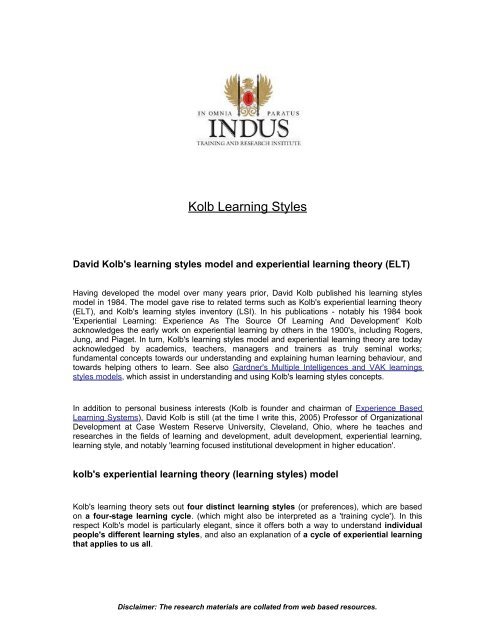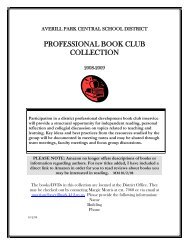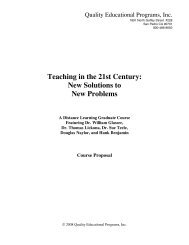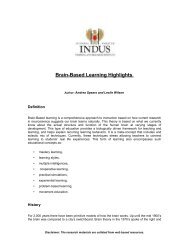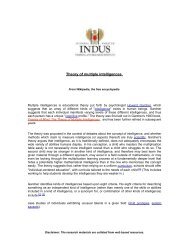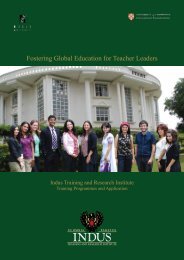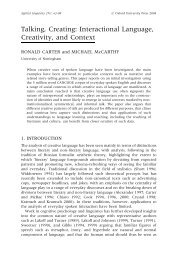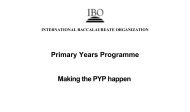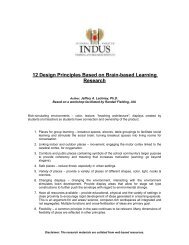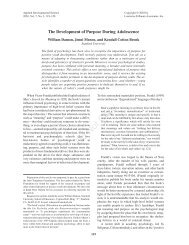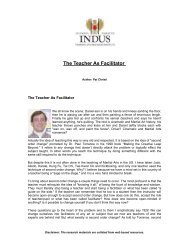Kolb Learning Styles - ITARI
Kolb Learning Styles - ITARI
Kolb Learning Styles - ITARI
You also want an ePaper? Increase the reach of your titles
YUMPU automatically turns print PDFs into web optimized ePapers that Google loves.
<strong>Kolb</strong> <strong>Learning</strong> <strong>Styles</strong>David <strong>Kolb</strong>'s learning styles model and experiential learning theory (ELT)Having developed the model over many years prior, David <strong>Kolb</strong> published his learning stylesmodel in 1984. The model gave rise to related terms such as <strong>Kolb</strong>'s experiential learning theory(ELT), and <strong>Kolb</strong>'s learning styles inventory (LSI). In his publications - notably his 1984 book'Experiential <strong>Learning</strong>: Experience As The Source Of <strong>Learning</strong> And Development' <strong>Kolb</strong>acknowledges the early work on experiential learning by others in the 1900's, including Rogers,Jung, and Piaget. In turn, <strong>Kolb</strong>'s learning styles model and experiential learning theory are todayacknowledged by academics, teachers, managers and trainers as truly seminal works;fundamental concepts towards our understanding and explaining human learning behaviour, andtowards helping others to learn. See also Gardner's Multiple Intelligences and VAK learningsstyles models, which assist in understanding and using <strong>Kolb</strong>'s learning styles concepts.In addition to personal business interests (<strong>Kolb</strong> is founder and chairman of Experience Based<strong>Learning</strong> Systems), David <strong>Kolb</strong> is still (at the time I write this, 2005) Professor of OrganizationalDevelopment at Case Western Reserve University, Cleveland, Ohio, where he teaches andresearches in the fields of learning and development, adult development, experiential learning,learning style, and notably 'learning focused institutional development in higher education'.kolb's experiential learning theory (learning styles) model<strong>Kolb</strong>'s learning theory sets out four distinct learning styles (or preferences), which are basedon a four-stage learning cycle. (which might also be interpreted as a 'training cycle'). In thisrespect <strong>Kolb</strong>'s model is particularly elegant, since it offers both a way to understand individualpeople's different learning styles, and also an explanation of a cycle of experiential learningthat applies to us all.Disclaimer: The research materials are collated from web based resources.
<strong>Kolb</strong> includes this 'cycle of learning' as a central principle his experiential learning theory, typicallyexpressed as four-stage cycle of learning, in which 'immediate or concrete experiences'provide a basis for 'observations and reflections'. These 'observations and reflections' areassimilated and distilled into 'abstract concepts' producing new implications for action which canbe 'actively tested' in turn creating new experiences.<strong>Kolb</strong> says that ideally (and by inference not always) this process represents a learning cycle orspiral where the learner 'touches all the bases', ie., a cycle of experiencing, reflecting, thinking,and acting. Immediate or concrete experiences lead to observations and reflections. Thesereflections are then assimilated (absorbed and translated) into abstract concepts with implicationsfor action, which the person can actively test and experiment with, which in turn enable thecreation of new experiences.<strong>Kolb</strong>'s model therefore works on two levels - a four-stage cycle:1. Concrete Experience - (CE)2. Reflective Observation - (RO)3. Abstract Conceptualization - (AC)4. Active Experimentation - (AE)and a four-type definition of learning styles, (each representing the combination of twopreferred styles, rather like a two-by-two matrix of the four-stage cycle styles, as illustratedbelow), for which <strong>Kolb</strong> used the terms:1. Diverging (CE/RO)2. Assimilating (AC/RO)3. Converging (AC/AE)4. Accommodating (CE/AE)Diagrams of kolb's learning styles(<strong>Kolb</strong> diagrams updated May 2006)Disclaimer: The research materials are collated from web based resources.
See also the personality styles and models section for help with understanding how <strong>Kolb</strong>'s theorycorrelates with other personality models and psychometrics (personality testing).<strong>Learning</strong> styles(This interpretation was amended and revised March 2006)<strong>Kolb</strong> explains that different people naturally prefer a certain single different learning style. Variousfactors influence a person's preferred style: notably in his experiential learning theory model(ELT) <strong>Kolb</strong> defined three stages of a person's development, and suggests that our propensity toreconcile and successfully integrate the four different learning styles improves as we maturethrough our development stages. The development stages that <strong>Kolb</strong> identified are:1. Acquisition - birth to adolescence - development of basic abilities and 'cognitivestructures'2. Specialization - schooling, early work and personal experiences of adulthood - thedevelopment of a particular 'specialized learning style' shaped by 'social, educational, andorganizational socialization'3. Integration - mid-career through to later life - expression of non-dominant learning style inwork and personal life.Disclaimer: The research materials are collated from web based resources.
Whatever influences the choice of style, the learning style preference itself is actually the productof two pairs of variables, or two separate 'choices' that we make, which <strong>Kolb</strong> presented as lines ofaxis, each with 'conflicting' modes at either end:Concrete Experience - CE (feeling) -----V-----Abstract Conceptualization - AC (thinking)Active Experimentation - AE (doing)-----V----- Reflective Observation - RO (watching)A typical presentation of <strong>Kolb</strong>'s two continuums is that the east-west axis is called the ProcessingContinuum (how we approach a task), and the north-south axis is called the PerceptionContinuum (our emotional response, or how we think or feel about it).These learning styles are the combination of two lines of axis (continuums) each formed betweenwhat <strong>Kolb</strong> calls 'dialectally related modes' of 'grasping experience' (doing or watching), and'transforming experience' (feeling or thinking):Disclaimer: The research materials are collated from web based resources.
The word 'dialectally' is not widely understood, and yet carries an essential meaning, namely'conflicting' (its ancient Greek root means 'debate'). <strong>Kolb</strong> meant by this that we cannot do both atthe same time, and to an extent our urge to want to do both creates conflict, which we resolvethrough choice when confronted with a new learning situation. We internally decide whether wewish to do or watch, and at the same time we decide whether to think or feel.The result of these two decisions produces (and helps to form throughout our lives) the preferredlearning style, hence the two-by-two matrix below. We choose a way of 'grasping the experience',which defines our approach to it, and we choose a way to 'transform the experience' intosomething meaningful and usable, which defines our emotional response to the experience. Ourlearning style is a product of these two choice decisions:1. how to approach a task - ie., 'grasping experience' - preferring to (a) watch or (b) do ,and2. our emotional response to the experience - ie., 'transforming experience' - preferring to(a) think or (b) feel.In other words we choose our approach to the task or experience ('grasping the experience')by opting for 1(a) or 1(b):• 1(a) - though watching others involved in the experience and reflecting on what happens('reflective observation' - 'watching') or• 1(b) - through 'jumping straight in' and just doing it ('active experimentation' - 'doing')And at the same time we choose how to emotionally transform the experience into somethingmeaningful and useful by opting for 2(a) or 2(b):• 2(a) - through gaining new information by thinking, analyzing, or planning ('abstractconceptualization' - 'thinking') or• 2(b) - through experiencing the 'concrete, tangible, felt qualities of the world' ('concreteexperience' - 'feeling')The combination of these two choices produces a preferred learning style. See the matrix below.<strong>Kolb</strong>'s learning styles - matrix viewIt's often easier to see the construction of <strong>Kolb</strong>'s learning styles in terms of a two-by-two matrix.The diagram also highlights <strong>Kolb</strong>'s terminology for the four learning styles; diverging, assimilating,and converging, accommodating:doing (Active Experimentation -AE)watching (ReflectiveObservation - RO)feeling (ConcreteExperience - CE)accommodating (CE/AE)diverging (CE/RO)Disclaimer: The research materials are collated from web based resources.
thinking (AbstractConceptualization - AC)converging (AC/AE)assimilating (AC/RO)Thus, for example, a person with a dominant learning style of 'doing' rather than 'watching' thetask, and 'feeling' rather than 'thinking' about the experience, will have a learning style whichcombines and represents those processes, namely an 'Accommodating' learning style, in <strong>Kolb</strong>'sterminology.<strong>Kolb</strong> learning styles definitions and descriptionsKnowing a person's (and your own) learning style enables learning to be orientated according tothe preferred method. That said, everyone responds to and needs the stimulus of all types oflearning styles to one extent or another - it's a matter of using emphasis that fits best with thegiven situation and a person's learning style preferences.Here are brief descriptions of the four <strong>Kolb</strong> learning styles:• Diverging (feeling and watching - CE/RO) - These people are able to look at thingsfrom different perspectives. They are sensitive. They prefer to watch rather than do,tending to gather information and use imagination to solve problems. They are best atviewing concrete situations several different viewpoints. <strong>Kolb</strong> called this style 'Diverging'because these people perform better in situations that require ideas-generation, forexample, brainstorming. People with a Diverging learning style have broad culturalinterests and like to gather information. They are interested in people, tend to beimaginative and emotional, and tend to be strong in the arts. People with the Divergingstyle prefer to work in groups, to listen with an open mind and to receive personalfeedback.• Assimilating (watching and thinking - AC/RO) - The Assimilating learning preferenceis for a concise, logical approach. Ideas and concepts are more important than people.These people require good clear explanation rather than practical opportunity. They excelat understanding wide-ranging information and organising it a clear logical format. Peoplewith an Assimilating learning style are less focused on people and more interested inideas and abstract concepts. People with this style are more attracted to logically soundtheories than approaches based on practical value. These learning style people isimportant for effectiveness in information and science careers. In formal learningsituations, people with this style prefer readings, lectures, exploring analytical models,and having time to think things through.• Converging (doing and thinking - AC/AE) - People with a Converging learning stylecan solve problems and will use their learning to find solutions to practical issues. Theyprefer technical tasks, and are less concerned with people and interpersonal aspects.People with a Converging learning style are best at finding practical uses for ideas andtheories. They can solve problems and make decisions by finding solutions to questionsand problems. People with a Converging learning style are more attracted to technicaltasks and problems than social or interpersonal issues. A Converging learning styleenables specialist and technology abilities. People with a Converging style like toexperiment with new ideas, to simulate, and to work with practical applications.Disclaimer: The research materials are collated from web based resources.
• Accommodating (doing and feeling - CE/AE) - The Accommodating learning style is'hands-on', and relies on intuition rather than logic. These people use other people'sanalysis, and prefer to take a practical, experiential approach. They are attracted to newchallenges and experiences, and to carrying out plans. They commonly act on 'gut'instinct rather than logical analysis. People with an Accommodating learning style willtend to rely on others for information than carry out their own analysis. This learning styleis prevalent and useful in roles requiring action and initiative. People with anAccommodating learning style prefer to work in teams to complete tasks. They set targetsand actively work in the field trying different ways to achieve an objective.As with any behavioural model, this is a guide not a strict set of rules.Nevertheless most people clearly exhibit clear strong preferences for a given learning style. Theability to use or 'switch between' different styles is not one that we should assume comes easilyor naturally to many people.Simply, people who have a clear learning style preference, for whatever reason, will tend to learnmore effectively if learning is orientated according to their preference.For instance - people who prefer the 'Assimilating' learning style will not be comfortable beingthrown in at the deep end without notes and instructions.People who like prefer to use an 'Accommodating' learning style are likely to become frustrated ifthey are forced to read lots of instructions and rules, and are unable to get hands on experienceas soon as possible.Relationships between kolb and other behavioural/personality theoriesAs with many behavioural and personality models, interesting correlations exist between <strong>Kolb</strong>'stheory and other concepts.For example, <strong>Kolb</strong> says that his experiential learning theory, and therefore the learning stylesmodel within it, builds on Carl Jung's assertion that learning styles result from people's preferredways of adapting in the world.Among many other correlations between definitions, <strong>Kolb</strong> points out that Jung's'Extraversion/Introversion' dialectical dimension - (which features and is measured in the Myers-Briggs Type Indicator [MBTI]) correlates with the 'Active/Reflective' (doing/watching) dialectic(east-west continuum) of <strong>Kolb</strong>'s model.Also, the MBTI 'Feeling/Thinking' dimension correlates with the <strong>Kolb</strong> model Concrete Experience/Abstract Conceptualization dimension (north-south continuum).Honey and Mumford's variation on the <strong>Kolb</strong> systemDisclaimer: The research materials are collated from web based resources.
Various resources (including this one in the past) refer to the terms 'activist', 'reflector', 'theorist',and 'pragmatist' (respectively representing the four key stages or learning steps) in seeking toexplain <strong>Kolb</strong>'s model. In fact, 'activist', 'reflector', 'theorist', and 'pragmatist' are from a learningstyles model developed by Honey and Mumford, which although based on <strong>Kolb</strong>'s work, isdifferent. Arguably therefore the terms 'activist', 'reflector', 'theorist', and 'pragmatist' effectively'belong' to the Honey and Mumford theory.Peter Honey and Alan Mumford developed their learning styles system as a variation on the <strong>Kolb</strong>model while working on a project for the Chloride corporation in the 1970's. Honey and Mumfordsay of their system:"Our description of the stages in the learning cycle originated from the work of David <strong>Kolb</strong>. <strong>Kolb</strong>uses different words to describe the stages of the learning cycle and four learning styles..."And, "...The similarities between his model and ours are greater than the differences.." (Honey &Mumford)In summary here are brief descriptions of the four H&M key stages/styles, which incidentally aredirectly mutually corresponding and overlaid, as distinct from the <strong>Kolb</strong> model in which the learningstyles are a product of combinations of the learning cycle stages. The typical presentation ofthese H&M styles and stages would be respectively at north, east, south and west on a circle orfour-stage cyclical flow diagram.1. 'Having an Experience' (stage 1), and Activists (style 1): 'here and now', gregarious,seek challenge and immediate experience, open-minded, bored with implementation.2. 'Reviewing the Experience' (stage 2) and Reflectors (style 2): 'stand back', gather data,ponder and analyse, delay reaching conclusions, listen before speaking, thoughtful.3. 'Concluding from the Experience' (stage 3) and Theorists (style 3): think thingsthrough in logical steps, assimilate disparate facts into coherent theories, rationallyobjective, reject subjectivity and flippancy.4. 'Planning the next steps' (stage 4) and Pragmatists (style 4): seek and try out newideas, practical, down-to-earth, enjoy problem solving and decision-making quickly, boredwith long discussions.There is arguably a strong similarity between the Honey and Mumford styles/stages and thecorresponding <strong>Kolb</strong> learning styles:• Activist = Accommodating• Reflector = Diverging• Theorist = Assimilating• Pragmatist = ConvergingReferences:Erikson's Psychosocial Theory of Human DevelopmentDisclaimer: The research materials are collated from web based resources.
Personality models and styles theoriesGardner's Multiple Intelligences and VAK learnings styles modelsFree VAK learning styles testFree multiple intelligences test (self-calculating MSExcel tool) - based on Gardner's modelBenziger's Thinking <strong>Styles</strong> and Brain DominanceKirkpatrick's learning evaluation modelBloom's Taxonomy of <strong>Learning</strong> DomainsDisclaimer: The research materials are collated from web based resources.


